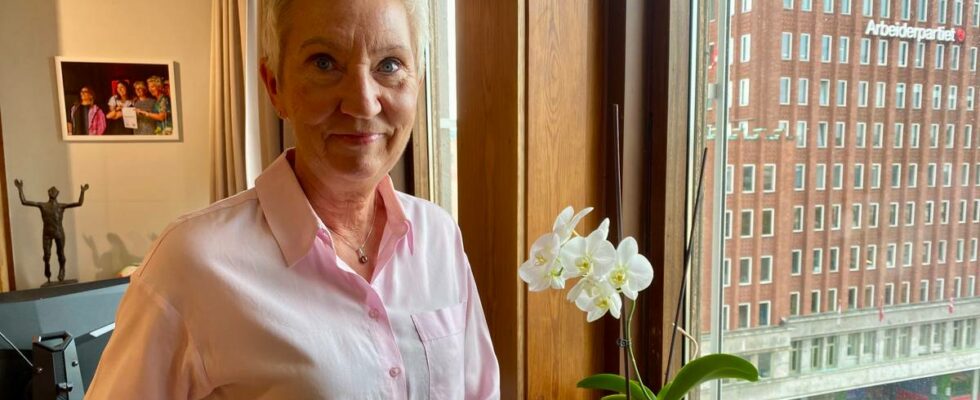On Monday, negotiations start on a new agreement to reduce sickness absence in Norwegian working life. One way towards the goal is to give employees greater confidence and save GPs work, believes LO leader Peggy Hessen Følsvik. – We propose to legislate the right to self-reports beyond the three days that are there today, in line with what applied to the previous IA agreement, says Følsvik to news. In practice, the proposal could mean that more people than today will not have to obtain a medical certificate if they are ill for more than three days. Companies can now arrange several self-reporting days with their employees, but are not required to do so. INCLUSIVE WORKING LIFE: LO leader Peggy Hessen Følsvik is getting ready for negotiations on a new agreement to reduce sickness absence. Photo: Kristian Skårdalsmo / news – How can extending the self-registration period reduce sickness absence? – If you have the opportunity to feel for yourself when you are ready to go to work again, people will also do it, says the LO boss. – Today, if you go to the doctor and receive a sick note, it is very often for, for example, a week. We know that many people end their sick leave period before they return to work, says Følsvik. LO indicates that previously there were up to eight self-reporting days in a row, up to 24 days a year. – Bad proposal The agreement on inclusive working life, on which negotiations are now starting, has existed since 2001. But sickness absence has nevertheless remained high – far too high, according to concerned politicians and economists. From 2019 to 2023, doctor-notified sickness absence increased from 4.8 to 5.6, a percentage growth of 17 per cent, the Nav analysis in “Work and Welfare” showed this summer. Sickness absence was 7.2 per cent for women and 4.2 per cent for men in 2023. In the negotiations, the employees in LO, YS, Akademikerne and Unio meet the employers in NHO, Virke, KS and Spekter. The Ministry of Labor and Inclusion is leading the talks. Norwegian: Spekter CEO Anne-Kari Bratten does not like LO’s proposal. Photo: Thomas T. Kleiven / Thomas T. Kleiven Anne Kari Bratten, who is head of the employers’ association Spekter, calls LO’s proposal un-Norwegian and says that many companies already today allow employees to have more self-registration days. – I think it is a surprising and very bad proposal. I think it is very un-Norwegian to legislate arrangements that work very well in trust-based dialogue, she says to news. – Many businesses in Spekter have given their employees confidence and given them an extended number of self-reporting days, she points out. The move shows that LO does not take the problem of sick leave seriously, says Venstre’s Sveinung Rotevatn. It is the sick pay scheme that needs to be changed, he believes. – There is obviously a need to change the sick pay scheme and tighten it. The fact that LO approaches the whole problem with the opposite approach shows that LO does not take sickness absence problems seriously, he says to news. TIGHTEN UP: Venstre’s Sveinung Rotevatn says LO does not take sick leave seriously. Photo: Kristian Skårdalsmo – Must change the scheme Long-term and doctor-notified sickness absence is the biggest challenge in working life. Today’s sick pay scheme – which provides full salary compensation for one year – will therefore be a topic in the negotiations on a new employment agreement. Følsvik flatly says no to weakening benefits in the current sick pay scheme. – I don’t think people will return to work any faster if they become poorer, she says. At the same time, LO and NHO have opened the door to find out whether the companies can take some more of the cost of long-term sick leave. Today, the employer covers the first 16 days, then the state picks up the bill. According to what news understands, the negotiations will discuss whether the limit can be moved from, for example, 16 to 12 days. Another topic that will be discussed is what percentage of the cost the companies should possibly be able to take. The purpose is to make it profitable for companies to get long-term sick leavers back to work. Rotevatn has a clear message for Minister Tonje Brenna (Ap): – She must change the sick pay scheme in line with what the experts have asked us to do, and as other countries do: The employer must have a longer co-financing responsibility, and employees must have a deductible. – The absence is too high State Secretary Ellen Bakken (Ap) in the Ministry of Labor and Inclusion is leading the negotiations, which must be finalized by 30 October. – Sickness absence is too high, and it must come down. There are many measures that we will now discuss together with the parties in working life, which we need to implement in order to reduce sickness absence. A new IA agreement must have effect. Legislating increased use of self-reporting is one means of action, she says. NEGOTIATIONS: State Secretary Ellen Bakken (Ap). Photo: Simen Gald – Are changes to the sick pay scheme needed to reduce sickness absence? – We are looking at many different instruments in the phase we are entering together with the parties in working life. Discussing changes in the financing of the sick pay scheme is one of the various things we discuss, says Bakken. – The IA agreement has existed for over 20 years and sickness absence has not been reduced. Was there any point then? – It is always a point to involve the parties in working life in finding solutions together. We also do not know what the sickness absence would have been like if we had not had these discussions with the parties at regular intervals. Published 05.09.2024, at 05.56
ttn-69
LO will legislate more self-reporting days – news Norway – Overview of news from different parts of the country

